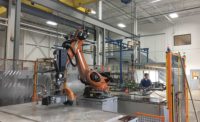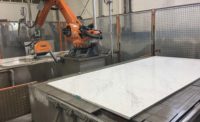Over his 25-year career in glass and stone processing for architectural applications, Kerry Clark had never been asked to find a tooling solution for creating artifacts for an art exhibition. Then one day, Clark, who is brand sales manager for Diamut America’s glass division, received a call from Miles Driscoll, design engineering manager at Precision Stone in Long Island, NY. Driscoll had been chosen to collaborate with noted architect and MIT teacher Cristina Parren᷉o on fabricating two artifacts for her upcoming exhibition at Art Omi in Ghent, NY. The exhibition, “TransTectonics in Construction,” would showcase a set of four artifacts that challenge conventional material assemblies through unorthodox translation of processes and tectonics.
Parren᷉o’s vision for her “Ghost of Stone” prototype was to use a massive carving technique typically associated with the tectonics of stone masonry but translated into the material of glass. Driscoll would also carve the rock for a piece shaped like “Ghost of Stone” that Parreño entitled “Rock in Full Metal Jacket” in which the machined volcanic rock would be joined with poured aluminum at MIT.
Parren᷉o would fabricate two other prototypes for the exhibition herself: “PlyGlass,” a provocation where the technique of lamination typically associated to plywood is applied to the material of glass creating transparent strength through redundancy. And “Wooden Bubble,” created by blowing glass on a wood mold, making the wood burn in the process.
After learning more about the project from Driscoll, Clark was eager to come up with the ideal tooling solution for carving “Ghost of Stone.” “Even though an art exhibition is not our typical project, we address new applications all the time for glass and stone shop customers,” he said. “When you think about it, every project that comes through the door really is a work of art to us. I am always challenged to come up with a solution for the fabricator to provide to the designer, who takes it to the architect. Projects often involve many technical and artistic challenges.”
Diamut makes tooling for most any machine on the market so that was the focus of Clark’s first question to Driscoll: “What machine will you use?” Roboticom’s Scultorob, a 7-axis robotic system for milling and turning operations on models and prototypes, was the response. “What material do you need to cut?” was another question asked. Originally, Parren᷉o had done some tests with glass block made with layers of laminated glass. Clark knew that sort of material is among the hardest to fabricate because it builds up on the tool’s diamond band and actually pulls away the diamonds from the bond. During Parren᷉o’s further exploration, solid glass block became the material of choice for the exhibit.
“Miles shared the drawings and explained that he needed tools for high removal and for intricate design,” Clark said. “Knowing all that, the best solution in my opinion was using several different sizes of our Cup Routers. Diamut Cup Routers are able to work on two fronts -- on their side and on their face. In the process, they actually do two jobs in one pass -- thick removal on one side and intricate design on the other at a 45-degree angle. For “Ghost of Stone,” Miles was going to have to make a back-and-forth type motion all the way from the largest portion, down to every minute tip of the prototype. He needed it to be stable with what we call free-cutting to ensure the cleanest cut possible. I also suggested operating parameters to help ensure the best quality -- giving him a full range of possibilities to create the desired intricacy.”
For Driscoll, the challenge of “Ghost of Stone” was taking down the glass block so nothing chipped off, achieving the right geometries. The first challenge for “Rock in Full Metal Jacket” was determining and sourcing the right material. “Volcanic rock, which is usually used as a landscaping boulder, is extremely soft,” he said. “Because it is light, not dense, and very porous, the poured aluminum could flow into it. The second challenge was that it milled very quickly.”
Both Clark and Driscoll knew realizing Parren᷉o’s vision and unique concepts would demand the utmost attention to detail. A licensed architect in Spain and the U.K., Parreno’s research in TransTectonics at MIT explores non-conventional assemblies of materials through small prototypes, later translated to larger scales and contexts to become architectural installations that activate public spaces.
“The concept behind this exhibition of 12 x 12 x 12 prototypes is extremely relevant for architecture,” Parren᷉o said. “It is a way of working with interesting materials, digital technology and super-advanced machines, but at the same time incorporating timed-honored craft, the old ways of working with materials.”
Anyone who attends the exhibition will see how each of Parreño’s pieces clearly stretches the limits of innovation in design research. Biesse Group and its Diamut subsidiary show similar intensity in pushing the limits of technology to deliver tooling and automation solutions to commercial shops that work with glass, stone and other materials.
“In Construction: Cristina Parren᷉o” ran from February 9 through March 17 in the Kantor Lobby of the Benenson Center at Art Omi.







